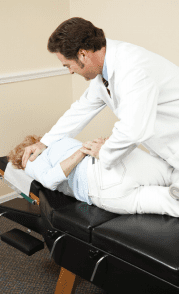 At some point, nearly everyone experiences back pain, especially low-back pain. This type of pain can feel sharp or it can be a dull ache with tingling, burning or numbness. Back pain is the second most common reason for a trip to the doctor and one of the major contributors to disability worldwide.
At some point, nearly everyone experiences back pain, especially low-back pain. This type of pain can feel sharp or it can be a dull ache with tingling, burning or numbness. Back pain is the second most common reason for a trip to the doctor and one of the major contributors to disability worldwide.
Researchers used to believe that back pain would heal on its own. Minor back injuries do often go away within a day or two. Although back pain may disappear temporarily, it is relatively likely to return. It has been demonstrated that more than 33 percent of people who experience low-back pain find that it lasts more than 30 days.
If your back pain does not resolve quickly, it may be the result of mechanical problems that a doctor of chiropractic (DC) can address. In addition to their expertise in spinal manipulation, DCs have broad diagnostic skills and are trained to recommend therapeutic and rehabilitative exercises, as well as to provide nutritional, dietary and lifestyle counseling. Many chiropractic patients with long-lasting or recurring back pain feel improvement shortly after starting chiropractic treatment.
How We Harm Our Backs
Many factors negatively affect our backs, including poor posture, improper lifting, reaching and twisting, and too much sitting. Certain occupations are known to be particularly hard on backs. For example, nursing home workers, delivery drivers, farmers, firefighters/ EMTs, landscapers and construction workers may strain their backs by lifting heavy objects or people. Auto mechanics and shingle roofers frequently twist their spines into physically awkward positions. Police officers strain their backs by sitting in their cars for prolonged periods, followed by bursts of strenuous activity. And heavy truck and tractortrailer drivers often compress their spines by sitting in one position in a vibrating vehicle for hours at a stretch, which can lead to disc degeneration.
Other Causes of Back Pain
Back pain does not necessarily result from straining the back with too much weekend basketball, golf or gardening. It can be caused by arthritis, obesity, psychological stress and diseases of the internal organs (e.g. kidney stones, kidney infections, blood clots or bone loss). Back pain can also last longer than expected when a patient, fearing further injury, cuts back on physical activity.
Chiropractic Treatment for Back Pain
With the abuse of prescription opioids in the United States now classified as an epidemic by the Centers for Disease Control and Prevention, utilizing non-drug treatments first to address pain makes sense. The essential services provided by doctors of chiropractic represent a primary care approach to the prevention, diagnosis and conservative management of back pain and spinal disorders that may potentially reduce or eliminate the need for pain medications.
The value of chiropractic’s conservative, drug-free approach to back pain treatment is supported in scientific literature. In a Journal of the American Medical Association article published in 2013, the authors suggested chiropractic for low-back pain (surgery was mentioned as an option only if all else fails). In another article, published in the medical journal Spine, researchers determined that adding spinal manipulation to standard medical care for low back pain yields a “significant advantage” in pain relief and physical functioning.
Recognizing the value of non-drug pain treatments, the Joint Commission, which accredits more than 20,000 health care systems in the U.S. including every major hospital, added chiropractic to its pain management standard in 2015.
Back Care and Injury Prevention
- Maintaining a healthy diet allows the spine to receive the nutrients it requires for good health. There’s nothing wrong with eating snack or junk foods occasionally. Problems arise, however, when we turn to such foods frequently. The calorie load from snack foods tends to be high and the nutrient value is either low or nonexistent.
- If you still smoke, look into quitting. Smoking impairs blood flow. When blood flow is impaired, that keeps oxygen and nutrients from reaching the tissues of the spine.
- The typical American lifestyle is far too sedentary. Our backs benefit when we take a break from sitting to walk around or exercise. Try taking 100 brisk steps every hour on the hour.
- Good ergonomics at the workstation helps the back. Many people hunch over their keyboards or reach for the mouse in a way that stresses the shoulder, neck and/or back. The mouse should always sit only a couple of inches from the keyboard.
- Remember to warm up before indulging in physical activities like gardening or exercising.
- When lifting something, bend the knees and keep the object close to the body. Above all, do not twist the body while lifting.
- When moving a heavy object, don’t pull. Push, instead.
- Let comfort be your guide when choosing the shoes you wear all day. Low-heeled shoes are best for posture and the back.
- When shopping for a mattress, look for one that’s of medium firmness to give your spine the proper support.
- A program of regular exercise will help to prepare the back and your muscles to respond in healthy, pain-free ways.
For Your Health,
Dr. Scott Van Dam

